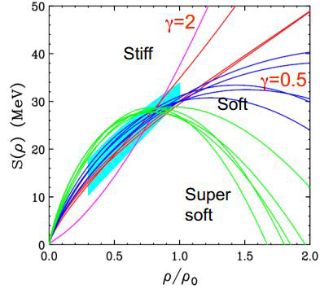|
Researchers: |
Position: |
|
Professor |
|
|
R. Lemmon |
Visiting Senior Research Fellow |
|
S. Gannon |
PhD Student |
|
W. Powell |
PhD Student |
|
P. Wigg |
PhD Student |
We investigate the properties of hadronic matter using the complementary approaches of AA and pA reactions. We are using heavy-ion reactions of neutron-rich nuclei to create high-density neutron-rich matter and then to measure its equation of state (EOS) with a variety of probes. In particular we are interested in investigating the density dependence of the symmetry energy and nucleon correlations in asymmetric nuclei.

Various predictions of the density dependence of the nuclear symmetry energy - M. B. Tsang, Prog. Part. Nucl. Phys 66, 400 (2011).
Our re-analysis of neutron-proton collective flow in Au+Au at 400 AMeV taken with the FOPI+LAND detectors at GSI (Germany) has provided the first laboratory constraints on the symmetry energy and the EOS of isospin-asymmetric matter at high densities. These results were used to propose a new dedicated experiment and provide more stringent constraints. This experiment was successfully completed by the ASYEOS Collaboration in 2011 and the analysis is ongoing.
We are also part of a new collaboration that is constructing a TPC to use with the SAMURAI experiment at RIBF-RIKEN (Japan). This is due to be completed and take beam in 2015 and will measure probes of the EOS such as sub-threshold pion production and neutron/proton flows with Radioactive Ion Beams. We are participating in the construction and commissioning of the SPIRIT TPC.
In a complimentary approach, we are pioneering the use of the (p,2p) reaction to probe the tensor correlations in isospin-asymmetric nuclei with the R3B (NuSTAR) experiment at GSI/FAIR. These correlations play a decisive role in determining the EOS of isospin-asymmetric matter at high densities. We have completed the data analysis of a pilot experiment with 12C in inverse kinematics at 400 AMeV at GSI, which has demonstrated the feasibility of such measurements. The construction of the new R3B Si Tracker (NuSTAR project) is ongoing, which our group leads. This is the largest nuclear physics construction project in the UK at the present time. It forms the core of the new target-recoil detector for the R3B experiment and will be used to select quasifree scattering reactions such as (p,2p), (p,pn) and (p,pα) with the very high-energy RIBs from the FAIR Facility (up to 1-2 AGeV).